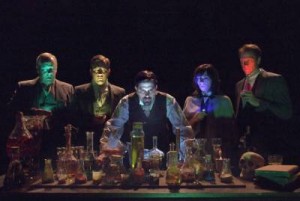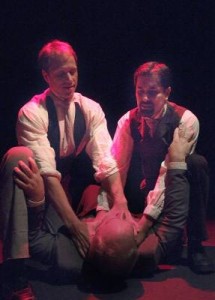RECOMMENDED
Theatre 40 undertakes something out of the ordinary in presenting the Los Angeles premiere of Jeffrey Hatcher’s Dr. Jekyll And Mr. Hyde, an experimental theater-style adaptation of Robert Lewis Stevenson’s classic of psychological suspense. Though Hatcher’s take on the Jekyll/Hyde tale proves problematic, an all-around fine cast under Jeff G. Rack’s frequently ingenious direction, as well as some particularly striking design elements, make this at the very least an interesting venture for Beverly Hills’ premier theater company. (It may also be the first time you’ve heard the title character’s surname pronounced JEE-kul. Apparently we’ve been getting it wrong till now.)
Hatcher picks a far less literal approach to Jekyll & Hyde than have most stage and film adaptations (including Frank Wildhorn’s popular musicalization). We enter multiple personality disorder-afflicted Dr. Jekyll’s adventures in evil midway through, Hatcher’s script pretty much skipping over whatever motivation the good doctor may have had in transforming himself into the murderous Mr. Hyde. In fact, it’s Hyde we glimpse first (in attack mode, naturally)—or should that be Hydes plural? A witness to Hyde’s attacks comments that “he has an elusive face.” No wonder, as Hatcher has four different actors (three male, one female) embodying Hyde. It’s anyone’s guess what the playwright’s intentions are, as a single actor playing both Jekyll and Hyde has worked perfectly fine in adaptation after adaptation until now. Still, regardless of intent, the result is nothing if not interesting (and highly theatrical) entertainment.
The quartet of Hydes (Silverio Avellino, David Hunt Stafford, Scott Roberts, Bernadette Bonfiglio as Hyde 1, 2, 3, and 4 respectively) are very different physical types and ages, and Hatcher (and director Rack) use them to interesting effect. Occasionally alone, at other times in groups of two, three, or four, the Hydes speak sometimes in unison, sometimes sequentially, sometimes parroting back Dr. Jekyll’s words. When Jekyll (Darren Tyler Morgan) finds himself surrounded by all four eerily lighted incarnations of his “other side,” the tableau makes for some spooky, scary effects.
All but two of the cast members play several supporting roles each, both large and small. Avellino is Jekyll’s close friend Gabriel Utterson, among others; Philip Persons is primarily Sir Danvers Carew, the doctor’s archrival; Roberts is Utterson’s friend Richard Enfield et al; and Stafford is mostly Jekyll colleague Dr. H.K. Lanyon and an inspector investigating the case. All five do excellent work, a variety of British accents helping distinguish between the characters (students, prostitutes, police officers, and street people) each portrays. Morgan makes for a heroic, troubled, multi-layered Jekyll, and Amy Moorman has many good moments as Elizabeth Jelkes, the young woman Hatcher has fall in love, not with Jekyll, but with Hyde(s).
Much of Hatcher’s dramatization focuses on Dr. Jekyll’s prickly relationship with Sir Danvers. There is a good deal of debate about Victorian morality versus medical science. Dr. Jekyll takes issue with Sir Danvers’ highly moralistic autopsy of a “diseased and depraved streetwalker,” opining that matters of the soul are best left to the clergy. Though this doesn’t stop Sir Danvers from declaring in no uncertain terms, “The whore shall be dissected tomorrow,” the cadaver ends up stolen and replaced by a monocle-wearing pig. Dr. Jekyll tells his good friend Utterson that “morality has harnessed but not killed our bestial impulses.” Meanwhile, believing that Dr. Jekyll’s foreign travels make him “suspect,” Sir Danvers plots to get him fired from his hospital position.
If this seems to be a less than clear synopsis of the play’s plot, it’s at least partly because Hatcher’s adaptation can be hard to follow. Perhaps the best way to enjoy this version of Stevenson’s classic is simply to sit back and enjoy the confusion.
David B. Marling’s sound design is one of his best, with disturbing growls and heavy breathing often providing a backdrop to the action, and Troy Lambert’s original rock score giving the production a hard-edged, contemporary feel. Director Rack does double duty as scenic designer, and it’s quite a versatile set he’s created. There’s a secret panel that slides a shelf of books out of sight to reveal a previously hidden alcove, thus transforming a library into another house’s living area. There’s a front door that not only spins around to show its inside face, but gets kicked open, falling dramatically to the floor not once but twice. Whenever the door represents Mr. Hyde’s front door, it’s lit a brilliant blood-red by Ellen Monocroussos, who’s done a sensational job as lighting designer. Despite a surprisingly late appearance in the tale, a laboratory table covered with foaming, bubbling, steaming vials and beakers of various shapes and colors illuminated from within is an Act 1 design highlight. Christine Cover Ferro’s Victorian era costumes couldn’t be better, though Moorman’s contemporary hairstyle distracts from her costumes’ period accuracy.
Ultimately, Hatcher’s Dr. Jekyll And Mr. Hyde proves an interesting attempt at combining a classic tale with experimental theatrical styles. Though it lacks the clarity that makes other film and stage adaptations easier to follow and more emotionally involving, it nonetheless makes for some frequently exciting theater.
Theatre 40, 241 S. Moreno Dr., Beverly Hills.
www.Theatre40.org
–Steven Stanley
November 4, 2009
Photos: Ed Krieger




 Since 2007, Steven Stanley's StageSceneLA.com has spotlighted the best in Southern California theater via reviews, interviews, and its annual StageSceneLA Scenies.
Since 2007, Steven Stanley's StageSceneLA.com has spotlighted the best in Southern California theater via reviews, interviews, and its annual StageSceneLA Scenies.







 COPYRIGHT 2024 STEVEN STANLEY :: DESIGN BY
COPYRIGHT 2024 STEVEN STANLEY :: DESIGN BY